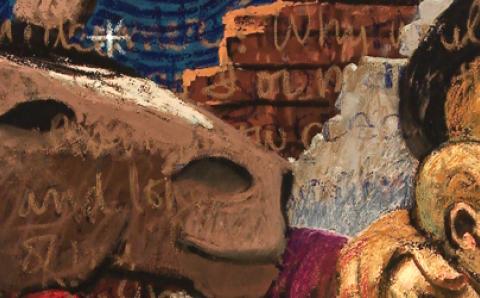Hi. My name is Sam. I’m 33 years old . . . and I believe in Santa Claus.
My brother and I discovered at a young age that my parents were the ones who “squeezed their way down our chimney” after we found a plethora of gifts hidden in the back of our 1971 blue Dodge van parked in the garage. It seemed as though “Santa” had arrived three weeks early and forgotten to lock the van doors.
As I said, I’m 33 years old, and for the first time in my life I’m starting to believe in Santa. Well, let me put it this way: I’m open to the possibility that Santa could exist. What is becoming increasingly important to me is not whether he actually exists, but the openness, imagination, willingness, and playful curiosity needed to believe in Santa.
I’m starting to think that a similar openness, imagination, and willingness help me to believe in Jesus.
My faith in Jesus seems just as bizarre as anything having to do with the Santa story.
“But Jesus really lives!” you might protest. “And Santa is just made up—at least the version most of us know.” That’s true. But when I think about it, my faith in Jesus seems just as bizarre as anything having to do with the Santa story.
Think about it: flying reindeer, a glowing red nose, a magic workshop, elves, a bottomless bag of toys, and a visit to every home on one night is just as weird as a crowd of 5,000 fed with barely anything, walking on water, money in the mouths of fish, voices from heaven, angel visitations, a virgin birth, a transfiguration, rising from the dead, magically appearing behind closed doors, and mind reading.
Having believed in Jesus for as long as I can remember, it’s easy for me to forget what Christianity may look like from the outside. Imagine if you heard the stories of Jesus for the very first time—what would you think?
In a culture that’s no longer steeped in the stories of the Bible, it’s good for us to remember that when we invite people to believe in Jesus, we are essentially inviting them to believe in an enchanted universe in stark contrast to the materialistic worldview that says “What you see is all there is.”
Christians postulate that the material is not the whole story. Instead, we assert that reality is infused with mystery, glory, spirit, paradox, truth, and invisible forces. Faith is about helping people cultivate the openness to believe in realities not seen.
One of my seminary professors talked about cultivating certain “capacities.” As we mature, these capacities need to grow and expand. One of the key capacities we can nurture and deepen is our capacity to imagine. In a culture that wants to do our imagining for us—asking us to passively absorb an overabundance of images—we need to be intentional about cultivating a healthy, vibrant imagination.
A healthy, vibrant adult imagination has a childlike capacity to hold the possibility that maybe—just maybe—Santa does exist.
Children seem to have no problem imagining that dragons, fairies, monsters, and unicorns exist. Sometimes it can even be difficult for them when someone “older and wiser” comes along and dismantles their belief in an enchanted universe.
This dismantling sometimes begins when an adult tells a young child for the first time that Santa does not exist. Yes, I admit, some of that needs to happen; we need to move beyond naïve, immature faith. But as we grow in Christ, we also need an expanded capacity to remember, imagine, and believe.
So if a child asks you this Christmas whether Santa exists, with a twinkle in your eyes try responding something like this: “I don’t know . . . but he could . . . he very well could.”
Hi, my name is Sam. I’m 33 years old . . . and I believe in Jesus.
About the Author
Sam Gutierrez is the Associate Director at the Eugene Peterson Center for the Christian Imagination at Western Theological Seminary. More of his creative work can be found at printandpoem.com









